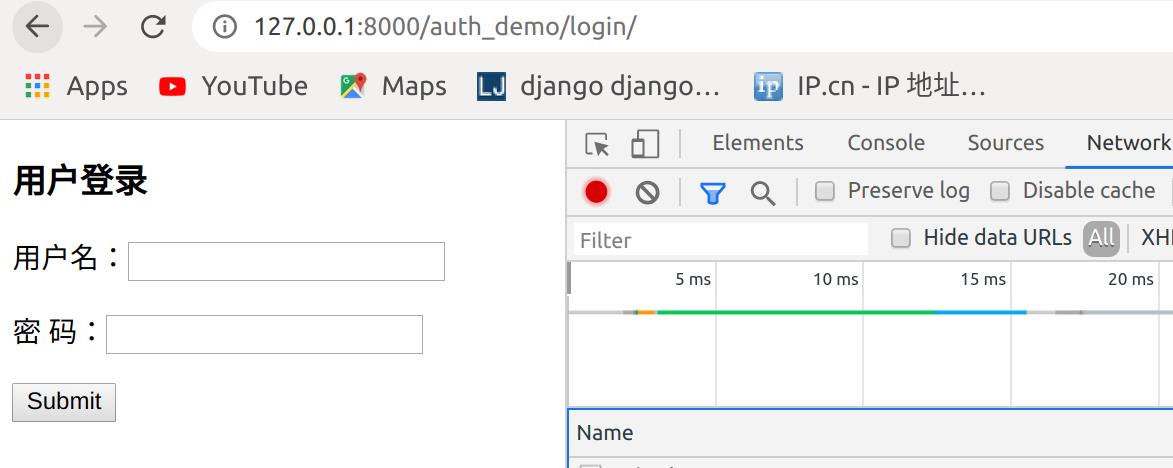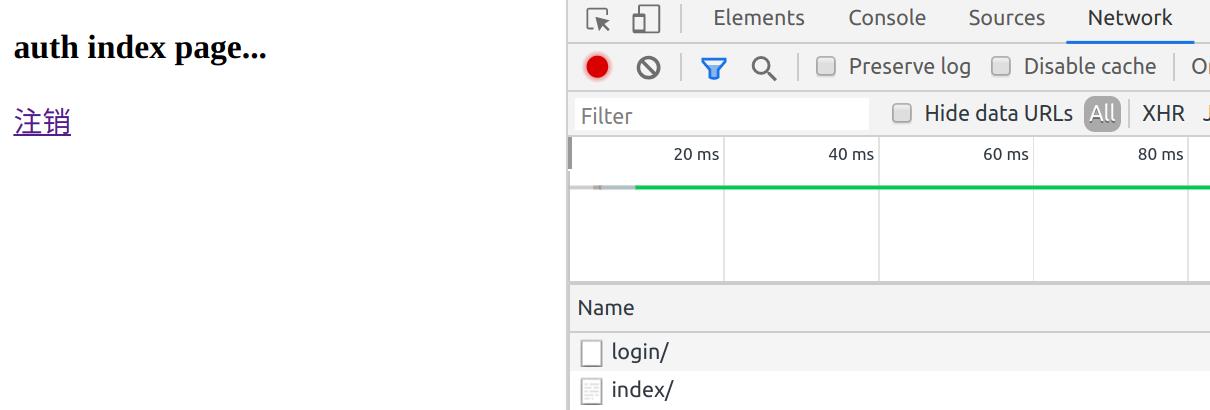061.Python前端Django组件用户认证组件
Posted 战五渣
tags:
篇首语:本文由小常识网(cha138.com)小编为大家整理,主要介绍了061.Python前端Django组件用户认证组件相关的知识,希望对你有一定的参考价值。
一 auth认证组件
在使用pymysql,数据库迁移的时候.,默认生成有十张表如下

查看author_user表结构
mysql> desc auth_user;
+--------------+--------------+------+-----+---------+----------------+ | Field | Type | Null | Key | Default | Extra | +--------------+--------------+------+-----+---------+----------------+ | id | int(11) | NO | PRI | NULL | auto_increment | | password | varchar(128) | NO | | NULL | | | last_login | datetime(6) | YES | | NULL | | | is_superuser | tinyint(1) | NO | | NULL | | | username | varchar(150) | NO | UNI | NULL | | | first_name | varchar(30) | NO | | NULL | | | last_name | varchar(150) | NO | | NULL | | | email | varchar(254) | NO | | NULL | | | is_staff | tinyint(1) | NO | | NULL | | | is_active | tinyint(1) | NO | | NULL | | | date_joined | datetime(6) | NO | | NULL | | +--------------+--------------+------+-----+---------+----------------+
在使用用户认证组件,必须使用django自带的author_user表
1.1 创建一个新的auth app
root@darren-virtual-machine:~/PycharmProjects/cookie_seesion# python3 manage.py startapp auth_demo
注册app
INSTALLED_APPS = [ \'django.contrib.admin\', \'django.contrib.auth\', \'django.contrib.contenttypes\', \'django.contrib.sessions\', \'django.contrib.messages\', \'django.contrib.staticfiles\', \'cookie.apps.CookieConfig\', \'session.apps.SessionConfig\', \'auth_demo.apps.AuthConfig\', ]
配置路由分发
from django.contrib import admin from django.urls import path,include urlpatterns = [ path(\'admin/\', admin.site.urls), path("cookie/",include("cookie.urls")), path("session/",include("session.urls")), path("auth_demo/",include("auth_demo.urls")), ]
配置路由
root@darren-virtual-machine:~/PycharmProjects/cookie_seesion# vim auth_demo/urls.py
from django.urls import path,re_path from auth_demo import views urlpatterns = [ path(\'index/\', views.index), path(\'login/\', views.login), ]
1.2 authenticate()用户认证
提供了用户认证,即验证用户名以及密码是否正确,一般需要username password两个关键字参数
如果认证信息有效,会返回一个 User 对象。authenticate()会在User 对象上设置一个属性标识那种认证后端认证了该用户,且该信息在后面的登录过程中是需要的。当我们试图登陆一个从数据库中直接取出来不经过authenticate()的User对象会报错的!!
1.3 login(HttpRequest, user)附加seesion信息
该函数接受一个HttpRequest对象,以及一个认证了的User对象
此函数使用django的session框架给某个已认证的用户附加上session id等信息。
root@darren-virtual-machine:~/PycharmProjects/cookie_seesion# vim auth_demo/views.py
from django.shortcuts import render,redirect,HttpResponse from django.contrib import auth # Create your views here. def index(request): return render(request,"auth_index.html") def login(request): if request.method == "GET": return render(request, "login.html") else: username = request.POST.get("username") password = request.POST.get("password") user = auth.authenticate(username=username,password=password) if user: auth.login(request,user) request.session["is_login"] = True return redirect("/auth_demo/index/") else: return redirect("/auth_demo/login/") return render(request,"login.html")
root@darren-virtual-machine:~/PycharmProjects/cookie_seesion# vim templates/auth_index.html
<!DOCTYPE html> <html lang="en"> <head> <meta charset="UTF-8"> <title>Title</title> </head> <body> <h3>auth index page...</h3> </body> </html>
访问http://127.0.0.1:8000/auth_demo/index/

都是干净没有seesion的
添加登陆限制
装饰器views配置
from django.shortcuts import render,redirect,HttpResponse from django.contrib import auth # Create your views here. def login_required(func): def inner(request,*args,**kwargs): if not request.user.is_authenticated: return redirect("/auth_demo/login/") rep = func(request,*args,**kwargs) return rep return inner @login_required def index(request): return render(request,"auth_index.html") def login(request): if request.method == "GET": return render(request, "login.html") else: username = request.POST.get("username") password = request.POST.get("password") user = auth.authenticate(username=username,password=password) if user: auth.login(request,user)return redirect("/auth_demo/index/") else: return redirect("/auth_demo/login/") return render(request,"login.html")
访问http://127.0.0.1:8000/auth_demo/index/,跳转到登录页面

1.4 创建用户
from django.contrib.auth.models import User #创建普通用户,密码明文 User.objects.create(username="joy",password="123456") #创建普通用户,密码密文 User.objects.create_user(username="john",password="123456") #创建超级管理员用户,密码密文 User.objects.create_superuser(username="darren",password="123456",email="darren@163.com")
查看数据库

使用joy账户不能登录,使用john和darren账户可以登录
登录后

已经有了seesionid
auth.login(request,user)源码
def login(request, user, backend=None): """ Persist a user id and a backend in the request. This way a user doesn\'t have to reauthenticate on every request. Note that data set during the anonymous session is retained when the user logs in. """ session_auth_hash = \'\' if user is None: user = request.user if hasattr(user, \'get_session_auth_hash\'): session_auth_hash = user.get_session_auth_hash() if SESSION_KEY in request.session: if _get_user_session_key(request) != user.pk or ( session_auth_hash and not constant_time_compare(request.session.get(HASH_SESSION_KEY, \'\'), session_auth_hash)): # To avoid reusing another user\'s session, create a new, empty # session if the existing session corresponds to a different # authenticated user. request.session.flush() else: request.session.cycle_key() try: backend = backend or user.backend except AttributeError: backends = _get_backends(return_tuples=True) if len(backends) == 1: _, backend = backends[0] else: raise ValueError( \'You have multiple authentication backends configured and \' \'therefore must provide the `backend` argument or set the \' \'`backend` attribute on the user.\' ) else: if not isinstance(backend, str): raise TypeError(\'backend must be a dotted import path string (got %r).\' % backend) request.session[SESSION_KEY] = user._meta.pk.value_to_string(user) request.session[BACKEND_SESSION_KEY] = backend request.session[HASH_SESSION_KEY] = session_auth_hash if hasattr(request, \'user\'): request.user = user rotate_token(request) user_logged_in.send(sender=user.__class__, request=request, user=user)
1.5 logout(request) 注销用户
该函数接受一个HttpRequest对象,无返回值。当调用该函数时,当前请求的session信息会全部清除。该用户即使没有登录,使用该函数也不会报错。
添加用户注销
<!DOCTYPE html> <html lang="en"> <head> <meta charset="UTF-8"> <title>Title</title> </head> <body> <h3>auth index page...</h3> <a href="/auth_demo/logout">注销</a> </body> </html>
路由
from django.urls import path,re_path from auth_demo import views urlpatterns = [ path(\'index/\', views.index), path(\'login/\', views.login), path(\'logout/\',views.logout), ]
视图文件
from django.shortcuts import render,redirect,HttpResponse from django.contrib import auth # Create your views here. def login_required(func): def inner(request,*args,**kwargs): if not request.user.is_authenticated: return redirect("/auth_demo/login/") rep = func(request,*args,**kwargs) return rep return inner @login_required def index(request): return render(request,"auth_index.html") def login(request): if request.method == "GET": return render(request, "login.html") else: username = request.POST.get("username") password = request.POST.get("password") user = auth.authenticate(username=username,password=password) if user: auth.login(request,user) return redirect("/auth_demo/index/") else: return redirect("/auth_demo/login/") def logout(request): auth.logout(request) return redirect("/auth_demo/login/")
访问

点击注销

添加一个order页面
from django.urls import path,re_path from auth_demo import views urlpatterns = [ path(\'index/\', views.index), path(\'login/\', views.login), path(\'logout\',views.logout), path(\'logout\',views.logout), ]
views视图文件
from django.shortcuts import render,redirect,HttpResponse from django.contrib import auth # Create your views here. def login_required(func): def inner(request,*args,**kwargs): if not request.user.is_authenticated: return redirect("/auth_demo/login/") rep = func(request,*args,**kwargs) return rep return inner @login_required def index(request): return render(request,"auth_index.html") def login(request): if request.method == "GET": return render(request, "login.html") else: username = request.POST.get("username") password = request.POST.get("password") user = auth.authenticate(username=username,password=password) if user: auth.login(request,user) return redirect("/auth_demo/index/") else: return redirect("/auth_demo/login/") def logout(request): auth.logout(request) return redirect("/auth_demo/login/") @login_required def order(request): return HttpResponse("order success")
这样访问http://127.0.0.1:8000/auth_demo/order会跳转到http://127.0.0.1:8000/auth_demo/login/
但是登录后

到了index页面,没有到order页面
User对象
User 对象属性:username, password(必填项)password用哈希算法保存到数据库
1.6 user对象的 is_authenticated
如果是真正的 User 对象,返回值恒为 True 。 用于检查用户是否已经通过了认证。
通过认证并不意味着用户拥有任何权限,甚至也不检查该用户是否处于激活状态,这只是表明用户成功的通过了认证。 这个方法很重要, 在后台用request.user.is_authenticated判断用户是否已经登录,如果true则可以向前台展示request.user.username
要求:
1 用户登陆后才能访问某些页面,
2 如果用户没有登录就访问该页面的话直接跳到登录页面
3 用户在跳转的登陆界面中完成登陆后,自动访问跳转到之前访问的地址
view视图设置
from django.shortcuts import render,redirect,HttpResponse from django.contrib import auth # Create your views here. def login_required(func): def inner(request,*args,**kwargs): if not request.user.is_authenticated: print(request.path) return redirect(\'/auth_demo/login/?next=%s\' % request.path) rep = func(request,*args,**kwargs) return rep return inner @login_required def index(request): return render(request,"auth_index.html") def login(request): if request.method == "GET": return render(request, "login.html") else: username = request.POST.get("username") password = request.POST.get("password") user = auth.authenticate(username=username,password=password) if user: auth.login(request,user) path = request.GET.get("next") return redirect(path) else: return redirect("/auth_demo/login/") def logout(request): auth.logout(request) return redirect("/auth_demo/login/") @login_required def order(request): return HttpResponse("order success")
访问http://127.0.0.1:8000/auth_demo/order跳转到http://127.0.0.1:8000/auth_demo/login/?next=/auth_demo/order

再次登录就到了order页面

点击注销,刷新一下再次登录报错

是因为这段代码在跳转会获取一个next参数,但是在直接登录,没有next参数
path = request.GET.get("next") return redirect(path)
处理
from django.shortcuts import render,redirect,HttpResponse from django.contrib import auth # Create your views here. def login_required(func): def inner(request,*args,**kwargs): if not request.user.is_authenticated: print(request.path) return redirect(\'/auth_demo/login/?next=%s\' % request.path) return redirect("/auth_demo/login/") rep = func(request,*args,**kwargs) return rep return inner @login_required def index(request): return render(request,"auth_index.html") def login(request): if request.method == "GET": return render(request, "login.html") else: username = request.POST.get("username") password = request.POST.get("password") user = auth.authenticate(username=username,password=password) if user: auth.login(request,user) #方法三 path = request.GET.get("next") or "/auth_demo/index/" #方法二 #path = request.GET.get("next","/auth_demo/index/") #方法一 #if not path: # path = "/auth_demo/index/" return redirect(path) else: return redirect("/auth_demo/login/") def logout(request): auth.logout(request) return redirect("/auth_demo/login/") def logout(request): auth.logout(request) return redirect("/auth_demo/login/") @login_required def order(request): return HttpResponse("order success")
登录成功

1.7 内置装饰器
上面的功能可以使用内置的一个装饰器完成
http://127.0.0.1:8000/auth_demo/order/变成http://127.0.0.1:8000/accounts/login/?next=/auth_demo/order/
原因,是因为在源码里面
1从这里进去

进入settings

找到global_seettings

这里设置
![]()
在用户的setting配置,这里的优先级高于global_settings
root@darren-virtual-machine:~/PycharmProjects/cookie_seesion# vim cookie_seesion/settings.py
LOGIN_URL = \'/auth_demo/login/\'
再次访问http://127.0.0.1:8000/auth_demo/order/跳转到http://127.0.0.1:8000/auth_demo/login/?next=/auth_demo/order/已经正常
1.8 添加用户注册页面
from django.urls import path,re_path from auth_demo import views urlpatterns = [ path(\'index/\', views.index), path(\'login/\', views.login), path(\'logout/\',views.logout), path(\'order/\',views.order), path(\'register/\',views.register), ]
register.html添加注册表单
root@darren-virtual-machine:~/PycharmProjects/cookie_seesion# vim templates/register.html
<!DOCTYPE html> <html lang="en"> <head> <meta charset="UTF-8"> <title>Title</title> </head> <body> <h3>用户注册</h3> <form action="" method="post"> {% csrf_token %} <p>用户名: <input type="text" name="username"></p> <p>密码: <input type="password" name="password1"></p> <p>确认密码: <input type="password" name="password2"></p> <input type="submit"> </form> </body> </html>
配置views
from django.shortcuts import render,redirect,HttpResponse from django.contrib import auth from django.contrib.auth.decorators import login_required from django.contrib.auth.models import User # Create your views here. #def login_required(func): # def inner(request,*args,**kwargs): # if not request.user.is_authenticated: # print(request.path) # return redirect(\'/auth_demo/login/?next=%s\' % request.path) # return redirect("/auth_demo/login/") # rep = func(request,*args,**kwargs) # return rep # return inner @login_required def index(request): return render(request,"auth_index.html") def login(request): if request.method == "GET": return render(request, "login.html") else: username = request.POST.get("username") password = request.POST.get("password") user = auth.authenticate(username=username,password=password) if user: auth.login(request,user) #方法三 path = request.GET.get("next") or "/auth_demo/index/" #方法二 #path = request.GET.get("next","/auth_demo/index/") #方法一 #if not path: # path = "/auth_demo/index/" return redirect(path) else: return redirect("/auth_demo/login/") def logout(request): auth.logout(request) return redirect("/auth_demo/login/") def logout(request): auth.logout(request) return redirect("/auth_demo/login/") @login_required def order(request): return HttpResponse("order success") def register(request): if request.method == "GET": return render(request,"register.html") 以上是关于061.Python前端Django组件用户认证组件的主要内容,如果未能解决你的问题,请参考以下文章